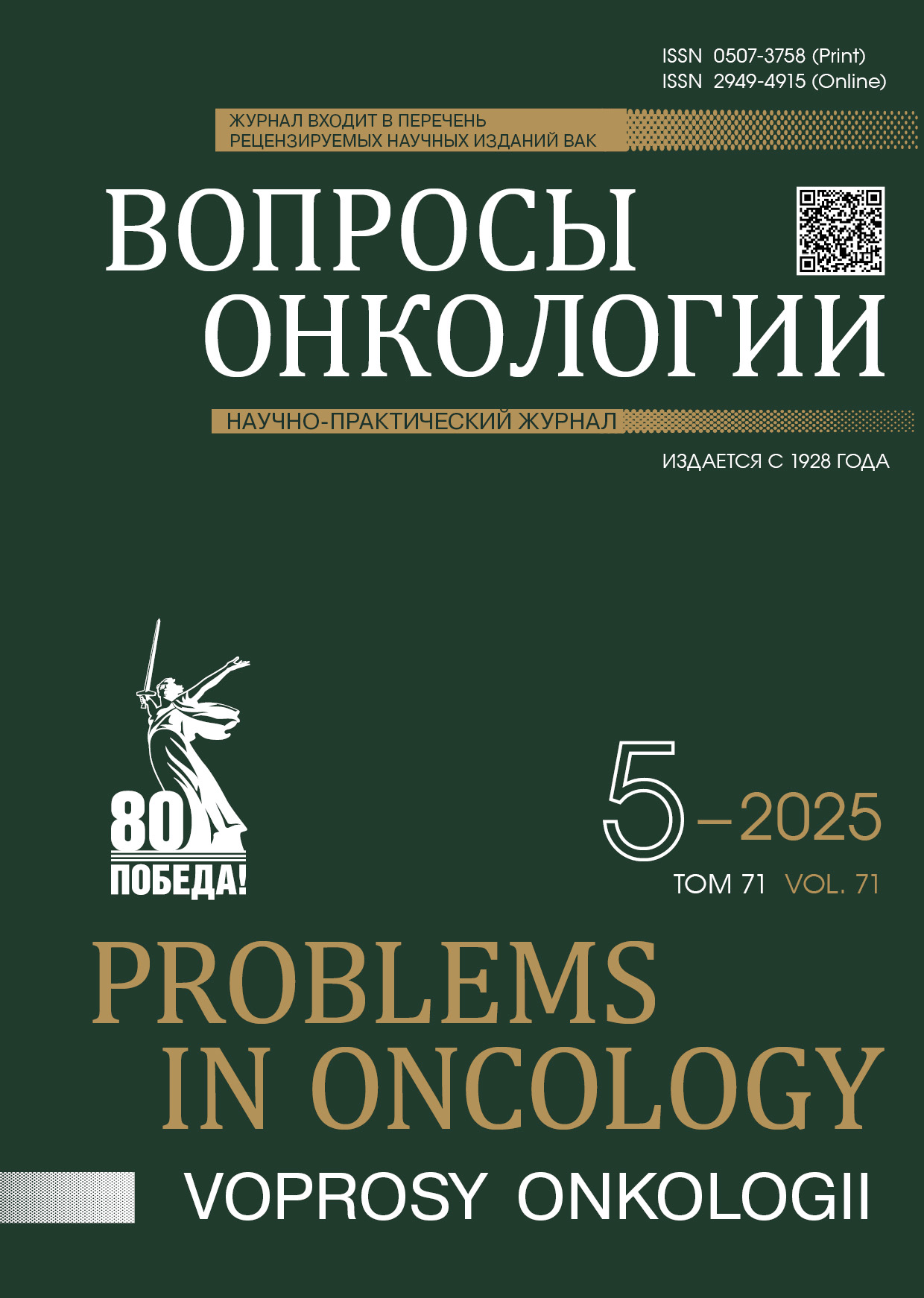Abstract
Introduction. The core concept of personalized nuclear medicine lies in developing theranostic pairs that enable simultaneous patient diagnosis and targeted therapeutic intervention.
Aim. To evaluate the efficacy of peptide receptor radionuclide therapy (PRRT) in patients with metastatic castration-resistant prostate cancer (mCRPC), neuroendocrine tumors (NETs), and advanced pancreatic tumors; to assess the incidence and severity of treatment-associated nephrotoxicity; and to explore the potential of the radiopharmaceutical agent Nanolute, Lu-177 for personalized treatment of patients with advanced renal and bladder cancers.
Materials and Methods. A total of 130 PRRT courses were administered to 33 patients with mCRPC and 18 patients with NETs, along with 10 PRRT courses administered to four patients with advanced progressive pancreatic tumors and receptor-negative NETs. Treatment response was assessed using PET/CT with the radiopharmaceuticals ⁶⁸Ga-PSMA, ⁶⁸Ga-DOTA-TATE, or ⁶⁸Ga-FAPI. Imaging intervals were 12–14 weeks during therapy and 3, 6, and 12 months post-treatment. Lesions were evaluated according to RECIST 1.1 criteria based on the CT component, and by the absence or emergence of new radiopharmaceutical-avid foci on PET. The radiopharmaceutical ¹⁷⁷Lu-Nanolutewas administered at doses ranging from 500–700 MBq to 2.9–3.0 GBq. Select patients received a nephroprotective protocol (albumin + furosemide, followed by volume replacement with saline and electrolytes).
Results. Based on PET/CT assessments, the objective response rate was 24.2 % (8 patients) in those with prostate cancer malignancies, while patients with NETs demonstrated a response rate of 44.4 % (8 patients). Peptide receptor radionuclide therapy was ineffective in 18 % (6 patients) with mCRPC. Progression-free survival among mCRPC patients ranged from 2 to 17 months, with a mean of 10.0 ± 4.8 months. Follow-up duration for NET patients ranged from 4 to 30 months, with a mean of 19.2 ± 10.0 months. Evaluation of the radiopharmaceutical Nanolute, Lu-177 revealed pathological tracer hyperaccumulation within tumor tissue, which correlated with administered activity, lesion size, and anatomical location. No renal parenchymal damage was observed in any patient undergoing therapy with these radiopharmaceutical agents.
Conclusion. PRRT demonstrated high efficacy in patients with mCRPC and NETs, with outcomes, including progression-free survival, objective response rates, and adverse event profiles, comparable to published literature. The radiopharmaceutical Nanolute, Lu-177 represents a promising agent for the treatment of advanced renal and bladder cancers.
References
Петров С. Лечение излучением. Вестник Атомпрома: информационно-аналитическое издание. Медицина и биотехнологии. 2020; 10: 8-10. [Petrov S. Radiation treatment. Bulletin of Atomprom: information and analytical publication. Medicine and Biotechnology. 2020; 10: 8-10 (In Rus)]. https://atomvestnik.ru/2020/10/01/lechenie-izlucheniem/
Куриленко Т.С., Литвинов А.В. «Магическая пуля» Пауля Эрлиха (К 100-летию со дня смерти основоположника химиотерапии лауреата Нобелевской премии Пауля Эрлиха). Клиническая микробиология, антимикробная химиотерапия. 2015; 17(4): 291-296. [Kurylenko T.S., Litvinov A.V. “The Magic Bullet” by Paul Ehrlich (On the 100th anniversary of the death of the founder of chemotherapy, Nobel Prize winner Paul Ehrlich). Clinical Microbiology, Antimicrobial Chemotherapy. 2015; 17(4): 291-296 (In Rus)]. https://cyberleninka.ru/article/n/volshebnaya-pulya-ili-rozhdenie-himioterapii
Keston A., Ball R., Frantz V., Palmer W. Storage of radioactive iodine in a metastasis from thyroid carcinoma. Science. 1942; 95(2466): 362-363.-DOI: 10.1126/science.95.2466.362. https://pubmed.ncbi.nlm.nih.gov/17745299/
Leiter L., Seidlin S., Marinelli L., Baumann E. Adenocarcinoma of the thyroid with hyperthyroidism and functional metastases. J Clin Endocrinol Metab. 1946; 6(3): 247-261.-DOI: 10.1210/jcem-6-3-247. https://pubmed.ncbi.nlm.nih.gov/21025117/
Seidlin S., Rossman I., Oshry E., Siegel E. Radioiodine therapy of metastases from carcinoma of the thyroid: A six-year progress report. J Clin Endocrinol Metab. 1949; 9: 1122-1137.-DOI: 10.1210/jcem-9-11-1122. https://pubmed.ncbi.nlm.nih.gov/15395978/
Omer A., Cetin D., Harikrishna K., et al. [18F]-PET and fluorescence imaging agent targeting prostate-specific membrane antigen: First-in-human study. Clin Genitourin Cancer. 2021; 19(5): 405-416.-DOI: 10.1016/j.clgc.2021.03.011. https://pubmed.ncbi.nlm.nih.gov/33879400/
Kratochwil C., Bruchertseifer F., Rathke H., et al. Targeted α-therapy of metastatic castration-resistant prostate cancer with 225Ac-PSMA-617: swimmer-plot analysis suggests efficacy regarding duration of tumor control. J Nucl Med. 2018; 59(5): 795-802.-DOI: 10.2967/jnumed.117.203539. https://pubmed.ncbi.nlm.nih.gov/29326358/
Sathekge M., Bruchertseifer F., Vorster M., et al. Predictors of overall and disease-free survival in metastatic castration-resistant prostate cancer patients receiving 225Ac-PSMA-617 radioligand therapy. J Nucl Med. 2020; 61(1): 62-9.-DOI: 10.2967/jnumed.119.229229. https://pubmed.ncbi.nlm.nih.gov/31101746/
Yadav M.P., Ballal S., Sahoo R.K., et al. Efficacy and safety of 225Ac-PSMA-617 targeted alpha therapy in metastatic castration-resistant prostate cancer patients. Theranostics. 2020; 10(20): 9364-77.-DOI: 10.7150/thno.48107. https://pubmed.ncbi.nlm.nih.gov/32802197/
Feuerecker B., Tauber R., Knorr K., et al. Activity and adverse events of actinium-225-PSMA-617 in advanced metastatic castration-resistant prostate cancer after failure of lutetium-177-PSMA. Eur Urol. 2021; 79(3): 343-50.-DOI: 10.1016/j.eururo.2020.11.013. https://pubmed.ncbi.nlm.nih.gov/33293081/
van der Doelen M.J., Mehra N., van Oort I.M., et al. Clinical outcomes and molecular profiling of advanced metastatic castration-resistant prostate cancer patients treated with 225Ac-PSMA-617 targeted alpha-radiation therapy. Urol Oncol. 2021; 39(10): e7-729.e16.-DOI: 10.1016/j.urolonc.2020.12.002. https://pubmed.ncbi.nlm.nih.gov/33353867/
Rubira L., Deshayes E., Santoro L., et al. 225Ac-Labeled somatostatin analogs in the management of neuroendocrine tumors: From radiochemistry to clinic. Pharmaceutics. 2023; 15(4): 1051.-DOI: 10.3390/pharmaceutics15041051. https://pubmed.ncbi.nlm.nih.gov/37111537/
Sathekge M., Bruchertseifer F., Knoesen O., et al. 225Ac-PSMA-617 in chemotherapy-naive patients with advanced prostate cancer: a pilot study. Eur J Nucl Med Mol Imaging. 2019; 46(1): 129-38.-DOI: 10.1007/s00259-018-4167-0. https://pubmed.ncbi.nlm.nih.gov/30232539/
Zacherl M.J., Gildehaus F.J., Mittlmeier L., et al. First clinical results for PSMA-targeted α-therapy using 225Ac-PSMA-I&T in advanced-mCRPC patients. J Nucl Med. 2021; 62(5): 669-74.-DOI: 10.2967/jnumed.120.251017. https://pubmed.ncbi.nlm.nih.gov/33008928/
Satapathy S., Mittal B.R., Sood A., et al. Health-related quality-of-life outcomes with actinium-225-prostate specific membrane antigen-617 therapy in patients with heavily pretreated metastatic castration-resistant prostate cancer. Indian J Nucl Med. 2020; 35(4): 299-304.-DOI: 10.4103/ijnm.IJNM_130_20. https://pubmed.ncbi.nlm.nih.gov/33642753/
Rolleman E.J., Krenning E.P., Bernard B.F., et al. Long-term toxicity of [177Lu-DOTA0,Tyr3] octreotate in rats. Eur J Nucl Med Mol Imaging. 2007; 34: 219-227.-DOI: 10.1007/s00259-006-0232-1. https://pubmed.ncbi.nlm.nih.gov/17021812/

This work is licensed under a Creative Commons Attribution-NonCommercial-NoDerivatives 4.0 International License.
© АННМО «Вопросы онкологии», Copyright (c) 2025

